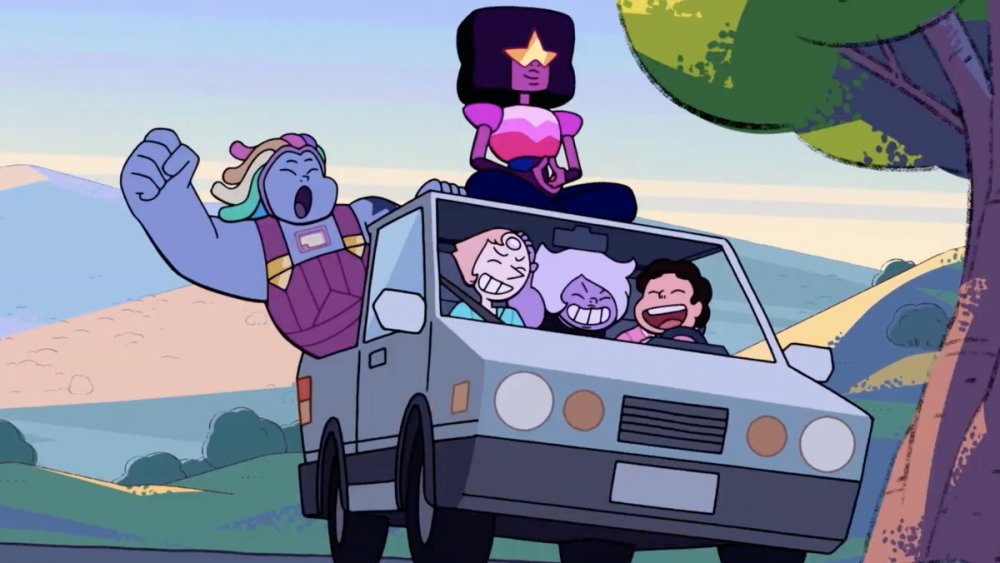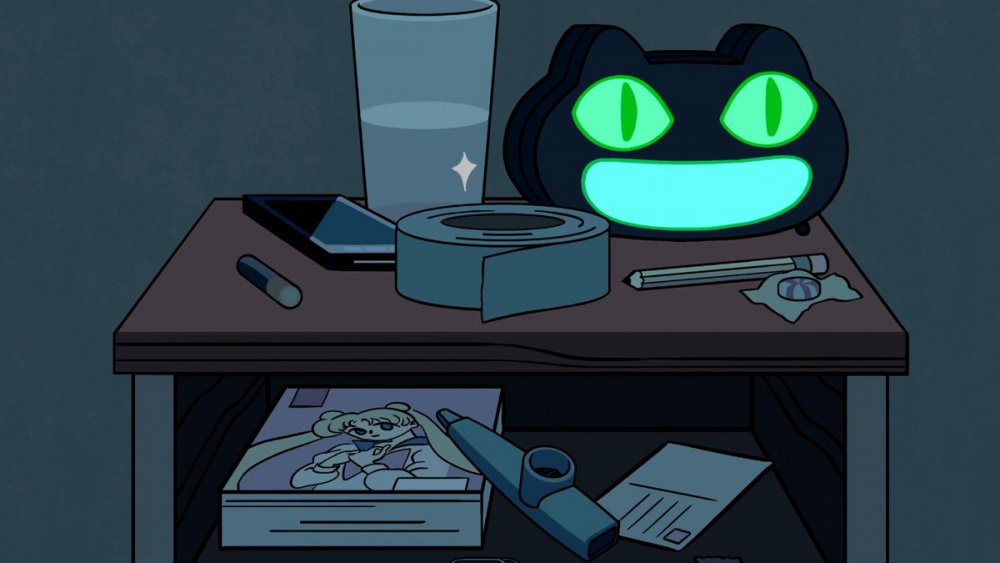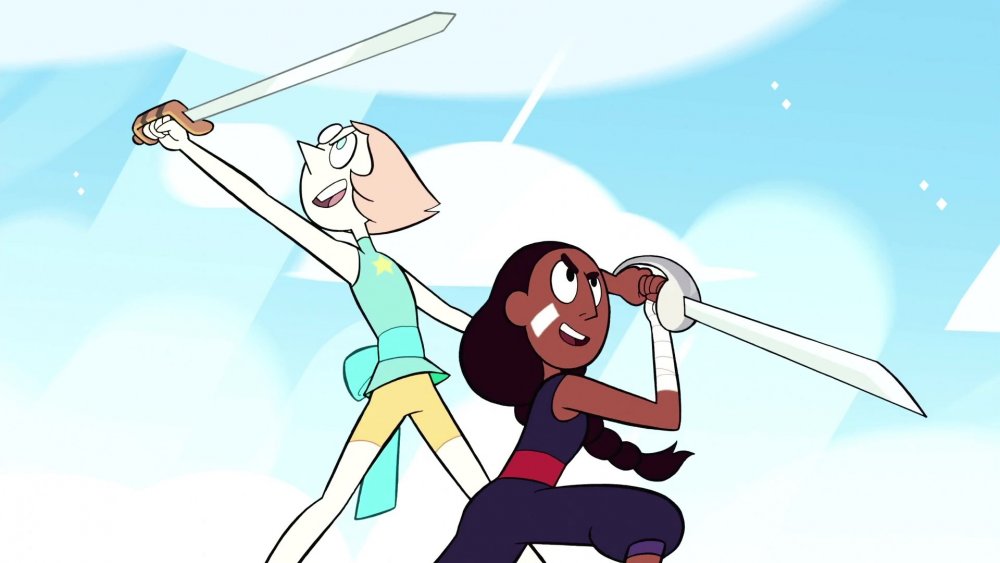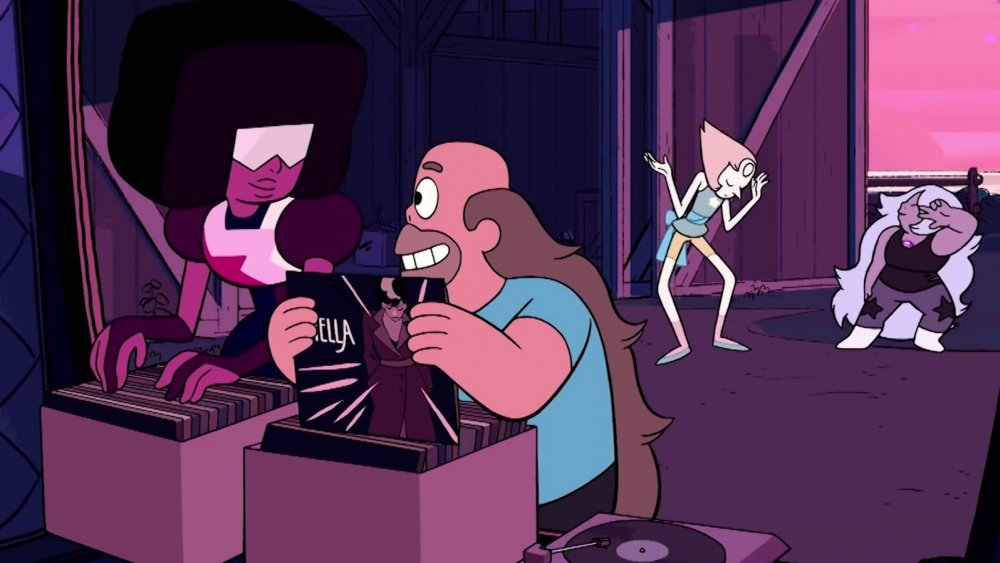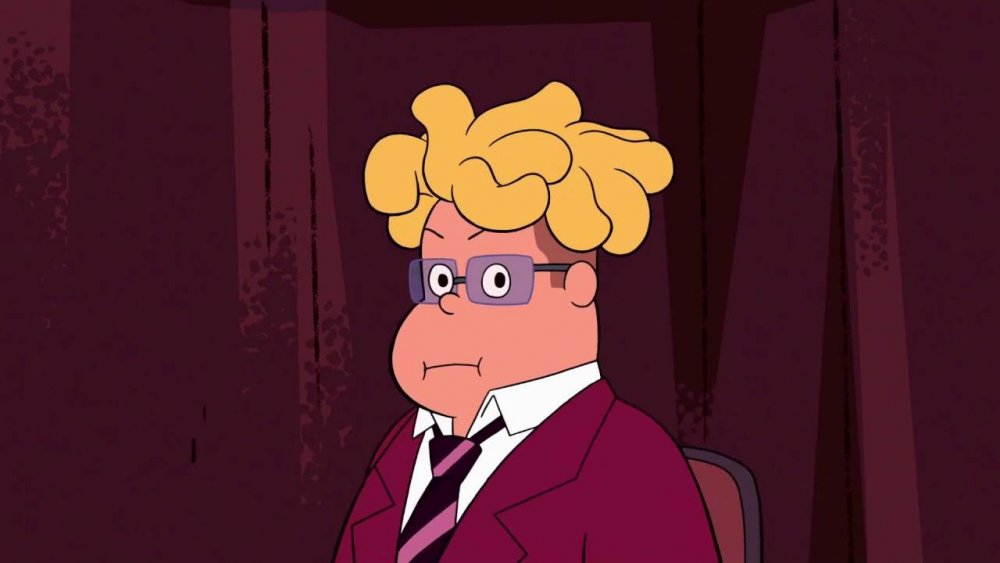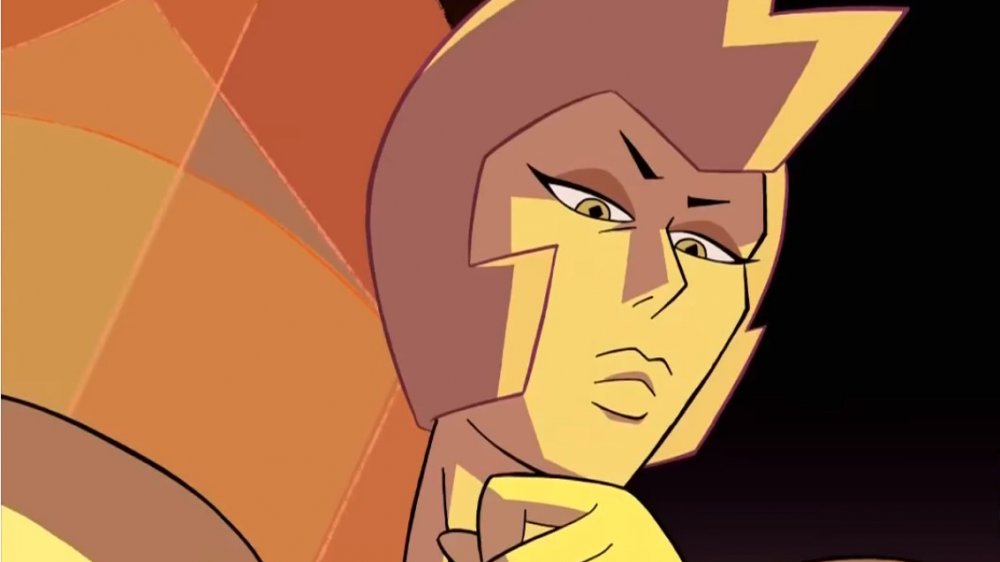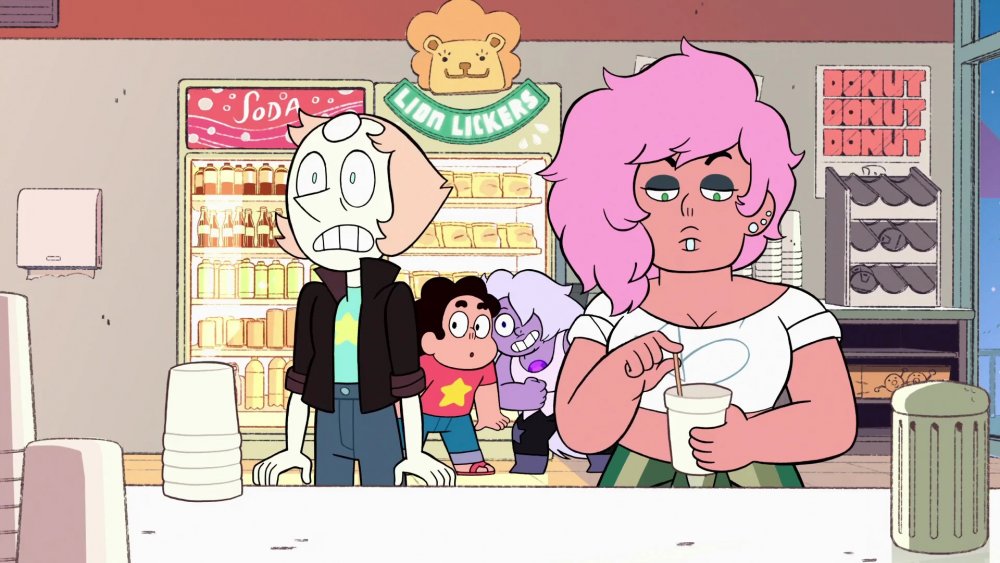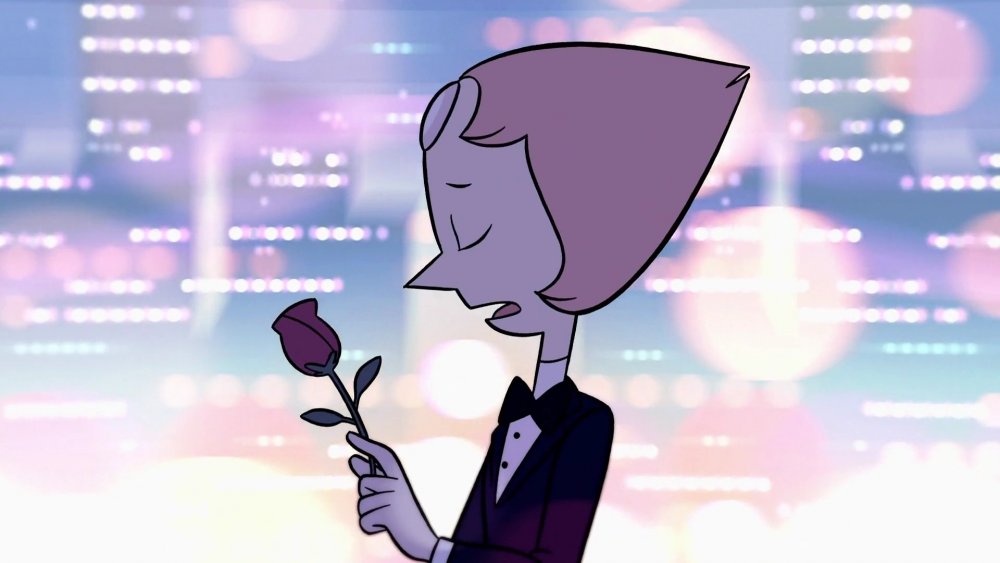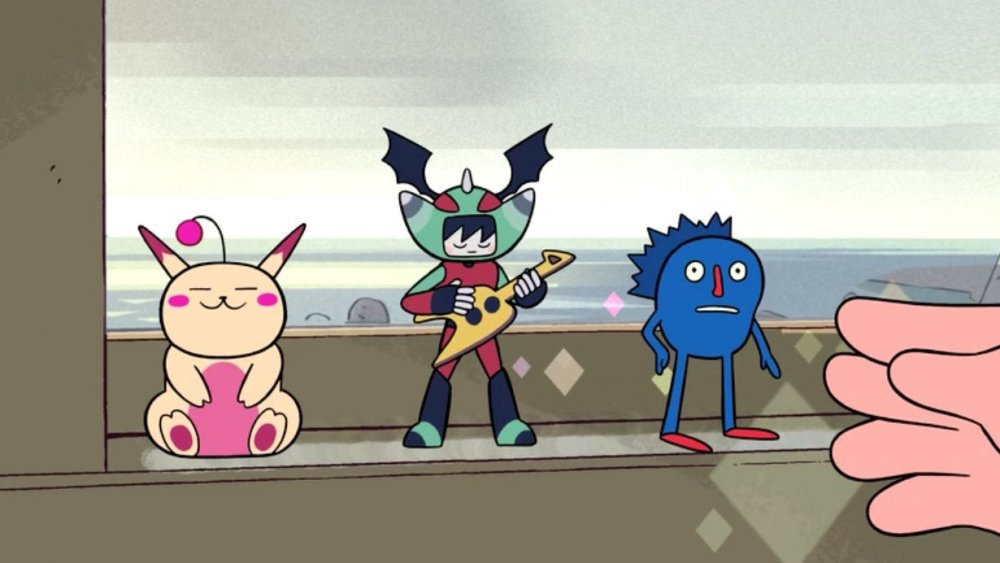Things Only Adults Notice In Steven Universe
Steven Universe is a hit with audiences of all ages. Fans thrill to its dazzling action, cheeky humor, and stirring character arcs, whether they're grade-schoolers or those who garner senior discounts at the movies. Who among us isn't moved by Steven's journey from excitable child into — well, still pretty excitable young adult, but one with a galaxy-spanning sense of responsibility and enough courage of conviction to topple an interstellar empire? What stonehearted malcontent doesn't find themselves singing along to "Love Like You"? Is there even a person alive who isn't intrigued by the concept of a Together Breakfast, with or without popcorn-topped waffles?
But for all that Steven Universe pleases fans young and old alike, there are more than a few scenes, references, and jokes buried within its pastel landscape, noticed solely by the adults in the audience. Do you know how many Broadway legends give voice to the homeworld Gems? How about the real-world bands hidden within Greg Universe's crates of vinyl? What 18th-century paintings did the Crystal Gems make a cameo in? We're here to explore all those moments only the grown-ups take note of, from the deepest cuts to the geekiest jokes.
An avalanche of anime references
Steven Universe might be an American production, but it's an absolute smorgasbord of references for any anime fan. Some are purely visual, as is the case in "Sworn to the Sword," in which Pearl introduces Connie to swordfighting: shots of Pearl in action are direct homages to Revolutionary Girl Utena, an anime which just so happens to feature a female knight devoted to a mercurial mistress. Some, as in "Nightmare Hospital," require an eagle eye: A "Dr. Gero" in charge of "Patient 20" is listed on the wall, referring to the Dragon Ball Z antagonist responsible for creating the Red Ribbon Androids, including Android 20. Some are truly unexpected: "The Test" culminates in the Gems clapping and congratulating Steven over a piano rendition of the theme song, a reference to the ending of Neon Genesis Evangelion, an anime infamous for its horror and pessimism.
What unites these references is just how darn delightful they are, and how well they illuminate the roots Steven Universe has in a variety of animation. But it's not all sly, under-the-radar nods: Steven himself is a canonical manga reader, evidenced by the volume of Sailor Moon that can be seen in his nightstand in "House Guest." One can't help but wonder: Do the Crystal Gems prefer English dubs or subtitles?
Watson and the... Crystal Gems?
Season 1 episode "So Many Birthdays" introduces a core concept of the Steven Universe saga: the fact that Gems don't age. Deep in the mounds of rubbish that fill Amethyst's room, Steven discovers a painting of the Gems in which they're dressed like "old-timey people:" Pearl's hair is styled like a powdered wig, Amethyst sports epaulets, and Garnet and Rose rock military jackets and cravats. Pearl explains that's because the painting is, in fact, old, going on to explain that Gems do not age like humans do.
Sharp-eyed viewers will notice, however, that the painting isn't just any old doodle. It is, in fact, a reference to John Singleton Copley's 1778 masterpiece, Watson and the Shark, a legendarily dramatic depiction of a shark attack off the coast of Havana, Cuba. The boy being menaced in the painting, Brook Watson, was, in fact, attacked by a shark, though he survived — minus his right leg below the knee. But in Steven Universe, it seems like Watson kept his leg intact: Garnet is seen delivering a righteous punch to the offending animal. As she quips, "the hard part was getting the shark to pose."
Connie, master of martial arts
"Sworn to the Sword" is an all-star episode of Steven Universe for a lot of reasons, foremost among them Connie's ascension to out-and-out butt-kicker. Driven to protect the Earth alongside Steven, she begins her sword training with Pearl — a skill that would become her signature over the course of the series. It's an intense process, but one she responds to eagerly: By the time the episode ends, her hair is pulled back in a no-nonsense braid, her hands are wrapped, and she's clad in a blue garment that allows her to flip, parry, and strike with ease.
But Connie's look isn't merely aesthetic: It's actually a reference to traditional uniforms worn by those who practice Kalaripayattu, an Indian martial art that began in modern-day Kerala. Kalaripayattu is one of the oldest martial arts in existence, and is taught as a way of life that emphasizes restraint, compassion, discipline, and respect. This mirrors Connie's journey exactly, especially her later struggles in using her training judiciously, and brings the character's Indian-American heritage to the fore. Moreover, the sword she carries is reminiscent of a khanda, a double-edged straight blade originating in India. Connie has a bright future ahead of her, given her intellect, study skills, and unbreakable determination, but if none of that works out, at least she could have a brilliant career in the world of Kalaripayattu cinema.
Greg's magical music collection
In a show full of extraordinary lives, Greg Universe lives one of the strangest. Sure, he might be a human, his car wash business considerably less impressive than, say, Garnet's existence as the magical fusion of two immortal aliens. But the dude was an indie rocker who fell in love with a runaway despot and managed to keep his cool when she decided to give up her form to become half of their unprecedented son. There are a lot of memories crowding that bald head, and they come tumbling out whenever his van is explored — largely in the form of music.
Enter Steven Universe's never-ending parade of music references. Greg's vinyl collection references Yellow Magic Orchesta, No Doubt, Estelle (who also voices Garnet), and Queen's 1977 News of the World album. When Steven asks him to help decrypt a message, Greg asks, "don't you know video killed the audio star?" referencing the 1979 Buggles hit "Video Killed the Radio Star." And that's not even getting into Greg's actual work as a musician, which is a non-stop riff off the 1980s' most starry-eyed, big-haired, grandiose hits. Greg might have settled down to raise his son, but even that hasn't stopped him from keeping up with musical tech: His Lubitz Cardioid Condenser 680, a microphone used in "The Message," is every joke about ultra-involved equipment rolled up in one giant microphone. But hey, at least it captures "warm tones without too much top-end."
Keep Beach City Nerdy
Ronaldo Fryman is a teen blessed with singular purpose: to keep Beach City weird. There is no conspiracy theory he will not indulge, no event he cannot spin as paranormal, and no place to which he will not bring the katana he bought at DelmarvaCon. This single-minded tenacity manifests in his blog, where he distributes "dispatches of TRUTH" and his celebrates his devotion to all things nerdy.
All of this makes Ronaldo one of the most memorable characters in Steven Universe. It also makes him a one-man dispensary of jokes about anime fandom. Ronaldo laments the way the snake people (or "sneeple") he believes control the world distract humanity with wars of "subs versus dubs," referring to that most ancient of anime arguments. He loves "I Can't Believe My Stepdad's My Sword," a title that manages to riff off anime with sentient weapons, a la Soul Eater and the wide world of massively long anime titles. He is devoted to Koala Princess, the series that brought him and his girlfriend together — or, as he likes to refer to her, his "ohime-sama." But before you roll your eyes at everything about Beach City's most notorious blogger, consider how living in a town with millennia-spanning alien shapeshifters might warp your sense of reality. After all, what is a Gem but the "polymorphic sentient rocks" he theorizes exist?
Yellow Diamond, Broadway legend
Steven Universe's cast features an absolute plethora of talent. Who among us can listen to Deedee Magno Hall sing "It's Over, Isn't It?" and not be moved? But this cast isn't just stacked with skill — it's studded with stars from theater to folk music. Kids might not notice these names, but savvy adults thrill to some of the biggest names around giving life to four-armed alien fusions.
Perhaps the most famous of these names is Nicki Minaj, who voiced Sugilite, the fusion of Garnet and Amethyst, with crackling aplomb. Aimee Mann, a legendary singer-songwriter with multiple Grammy Awards to her name, is another luminary lending her voice to a fusion as Opal, the fusion of Pearl and Amethyst. And then there's the Broadway talent of Steven Universe: Patti Lupone and Christine Ebersole. Lupone is an absolute icon of the stage, having given definitive performances in Evita, Gypsy, Anything Goes, and a variety of other classics of musical theater. Ebersole is similarly beloved for her work on the stage, particularly in Grey Gardens and 42nd Street. Respectively, they play Yellow Diamond and White Diamond, and regularly blow the minds of adults who can't believe they're watching Broadway legends play haughty alien dictators on a children's cartoon. Those who can't get enough of them are encouraged to check out the soundtrack to War Paint, the 2016 musical in which they starred as cosmetic industry titans Elizabeth Arden and Helena Rubenstein.
Connie and Steven vs. The Magisterium
Connie might be Steven Universe's very own swashbuckling swordswoman, but she's also a massive geek. Chief among her fannish obsessions is The Spirit Morph Saga, a series of fantasy novels she and Steven have spent many an afternoon discussing. Though they differ in opinion on the ending — Connie found it cheesy and abrupt, Steven loved every schmaltzy detail — they are united in their love for its awesome action, subversion of tropes, and extremely cool talking eagles.
But The Spirit Morph Saga isn't just any series. Astute adults will recognize it as a riff off many beloved fantasy series (and their attendant fan grumblings over endings and romances), principally Phillip Pullman's His Dark Materials. Like Materials, Saga features a heroine, here named Lisa instead of Pullman's Lyra, with great power she must learn to control and understand. Both Lyra and Lisa are accompanied by talking animal companions (Lyra's called a daemon, Lisa's called, as a title in her series implies, a familiar), both search for their fathers, and both series are subject to public pressure for their anti-authoritarian ideals. Connie's description of Saga could be a Materials review: "Rebels challenging the stifling traditions of the magical bureaucracy!" She and Steven might not always agree on every series detail, but there's no doubt their fandom binds them together, just as readers the world over enjoyed Pullman's magical world.
"Last One Out of Beach City" leans into teen tropes
"Last One Out of Beach City" is a delight of an episode from beginning to end. Pearl, determined to be laid back, accompanies Amethyst and Steven to a concert... and actually ends up becoming the coolest character by a galactic mile. She doesn't just run from the cops — she pulls off a popped collar and gets a girl's phone number while doing it!
It's the sort of installment anyone can love. But adults will enjoy just how many references it makes to teen movies and music of yore — and how deftly the episode as a whole encapsulates the spirit of that media. For one thing, the episode takes its title from Less Than Jake's "Last One Out of Liberty City," an ode to hometown angst par excellence. Then there's the ending sequence: The episode concludes with a rollicking guitar anthem from Mike Krol, crediting "PEARL as REPRESSED NERD," "AMETHYST as ULTIMATE WINGMAN," and so on. It brings to mind everything from John Hughes classics to modern masterpieces like To All The Boys I've Loved Before, with an irresistibly meta-textual twist. Finally, there is the mystery girl herself. Pearl's crush is every inch the teen dream, from her motorcycle to her lip ring, and the fact that she leaves behind only her first initial alongside her number is the icing on the cake. Hopefully, she and Pearl will meet again — killer guitar backing possibly included.
Peridot, ultimate shipper
Peridot: alien arbiter of Kindergarten quality, manipulator of metals, ardent Crystal Gem. She's come a long, long war from being the authoritarian she once was — and nothing symbolizes that transformation more than her love for Camp Pining Hearts. A Canadian teen soap, little is known about the show beyond the presence of the characters Percy, Pierre, and Paulette, the fact that it takes place at a summer camp, and Steven and Peridot's opinion that its fifth season is "trash."
This is amusing enough on its own, but all the more funny for adults who recognize Peridot's behavior as a deft parody of fandom dynamics. Peridot doesn't just ship, she constructs elaborate charts to deduce which pairing is, in her own words, "superior," then sets about converting all her friends to rooting for Percy and Pierre. A glance at her beloved tablet reveals every app necessary to an active fandom career, including Tumblr, Twitter, Instagram (plus...Tinder?). Peridot's Twitter account is, in fact, a very real thing, maintained by former crew member Jesse Zuke, wherein she discusses her fan theories about poutine, "maple syrup plot holes," and how much she loves playing the show at top volume when she's home alone. This isn't likely to be the happy ending anyone imagined for the one-time bureaucrat — but darn if it's not adorable. So long as she doesn't make those shipping wars literal.
Pearl pays homage to Julie Andrews
Every character in Steven Universe must reckon with their past, but few do it as memorably as Pearl. Watching her grow from the lovelorn figure she was, torn apart by the secrets Rose Quartz forced her to keep, into the self-possessed Gem she's become is one of the series' greatest triumphs — in large part because the journey was so arduous. No song emblematizes Pearl's struggles greater than "It's Over, Isn't' It?" from "Mr. Greg," in which she contemplates her inability to let Rose Quartz go, despite the fact of her death, betrayal, and relationship with Greg.
It's a stirring scene — made even more affecting to those adults who will recognize much of it as an homage. Most prominently, "It's Over, Isn't It?" pays tribute to the "Crazy World" scene in 1982's Victor/Victoria, in which Julie Andrews, clad in a tuxedo, laments her love for someone who just can't seem to treat her with consistent respect. Steven Universe creator Rebecca Sugar has gone on record as having been inspired by the scene, down to its mesmerizing 360-degree camerawork, which she described as "so simple and so powerful." As it was for Andrews, the slow, circular pan highlights Pearl's lament in all its complexity and frustration. As Andrews croons, Pearl tried to "hang on to hope" — thankfully learning, with time, to let Rose and all that she had with her go.
An arcade's worth of gaming references
Steven might be a planet-spanning hero, legendary for his compassion and courage, but he's still a kid of the modern world. As such, he loves video games — and boy, does Steven Universe love sneaking in as many gaming references as possible. Take Steven's windowsill, glimpsed for the briefest moment in "Steven the Sword Fighter." Lined up on its slim wooden beam is a who's-who of classic gaming: We've got Cloud Strife from Final Fantasy, a Moogle from the same game combined with Pikachu from Pokemon, Gitaroo Man from his titular series, and "Sanic Hegehog," the legendarily lumpen Sonic the Hedgehog meme.
That's all contained within one scene of a single episode. Elsewhere, we see Steven's impressive catalog of consoles, including a GameCube, Nintendo 64, Sega Genesis, and a Game Boy Color. Titles from Animal Crossing to Katamari Damacy can be seen in every room of his house. Mr. Smiley's Funland Arcade down on the Beach City boardwalk offers some particularly deep cuts for the nostalgic gamers out there: Teens of Rage, a parody of the Sega arcade game Streets of Rage, is available to be played there, as well as Meat Beat Mania (its name a parody of Beatmania, its gameplay a reference to Samba de Amigo), and Chrono Panic 4, which lumps arcade standbys Chrono Trigger and Time Crisis 4 into what must be a truly dizzying game. One question remains: does Steven play anything on PC?
